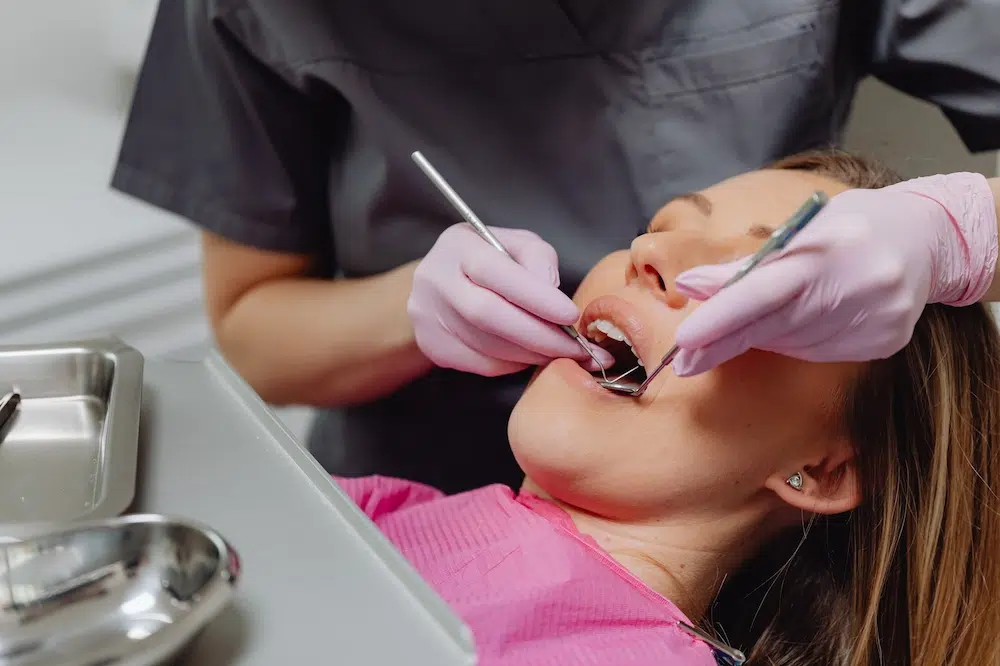
What Are The Dental Clues That An Adult Has OSA?
OSA stands for Obstructive Sleep Apnea. Think of it like when someone has trouble breathing while they sleep. Sometimes, our teeth and mouth can give hints that someone has OSA.
But what are the dental clues that an adult has OSA?
Just like when you play a game and look for clues, a dentist can look in your mouth for signs. These signs help them know if you might have OSA.
This topic is important because breathing well during sleep is vital for our health.
So, by looking at dental clues, we can spot OSA early and help people breathe better at night. Let’s dive in and see what these clues are.
Physical Examination
A physical examination is like a check-up for our body. Doctors look at different parts to see if everything is okay.
Now, let’s talk about some things they might check in our mouth and throat area.
Mouth Breathing:
Mouth breathing means you breathe through your mouth and not your nose. It’s not the best way to breathe. Nose breathing is better for us.
Enlarged Uvula:
The uvula is the small thing that hangs down at the back of our throat. Sometimes, it can get big. A big uvula can cause problems like loud snoring.
Tonsil Size:
Tonsils are like two small pillows at the back of our throats. They help fight germs. But if they get too big, they can block air and make it hard to breathe.
Crowded Teeth:
Sometimes, teeth can be too close together. This is called crowded teeth. They can push each other and look crooked. It’s essential to check them to keep our teeth healthy.
High Arched Palate:
The palate is the roof of our mouth. Some people have a palate that is high and curved like a hill.
It can affect how they speak or eat. Doctors check it to make sure it’s okay.
Dental Impressions
Dental impressions are like taking a picture of your mouth. It shows how your teeth and tongue look and if there are any problems.
Teeth Grinding (Bruxism)
Some people grind their teeth. It’s called bruxism. Imagine you’re trying to crush a nut using your teeth, but all the time it can hurt your teeth. Dentists can see signs of this and help you stop.
Tooth Wear Patterns
Our teeth have a way of showing how we use them. Some people may have spots that look more used than others.
It’s like when you use a pencil, and one side gets shorter. Dentists check this to help keep our teeth healthy.
TMJ Disorders
TMJ stands for a joint in our jaw. Sometimes this joint can have problems, and it might hurt or make noises.
It’s like a door hinge that needs oil. A dentist can see if there’s a TMJ problem and help fix it.
Dental Erosion
Dental erosion means our teeth are losing their hard part. It’s like a mountain slowly getting smaller because of rain.
Acidic foods or drinks can cause this. A dentist will check for erosion and give advice on how to protect our teeth.
Scalloped Tongue
Sometimes, the sides of our tongues have marks that look like waves. This is called a scalloped tongue.
It can be because of how our teeth press on it. A dentist can see this and tell us if it’s a problem or not.
X-Ray Findings
X-ray findings help doctors see inside our bodies. They can look at our bones and some other parts too.
This helps them find problems and decide how to help. Let’s talk about some common findings in the nose and throat area.
Deviated Septum
Inside our noses, there’s a thin wall. Sometimes, it’s not straight. We call this a deviated septum. It can make it hard to breathe.
Narrow Airway
Our throat has a passage for air. If it’s too narrow, breathing can be tough. It’s like trying to drink from a tiny straw.
Retrognathia
This is a fancy word that means the lower jaw is set back a bit. It’s not in line with the upper jaw. This can also make breathing hard.
Adenoid Size
Adenoids are like small lumps at the back of our noses. They help fight germs. But if they get too big, they can block the airway.
Airway Obstruction
This means something is blocking the air passage in our throats. It’s like a roadblock on a street. It can happen for many reasons.
Oral Appliance Therapy
Oral appliance therapy is a way to help people breathe better at night. It uses special devices for the mouth.
They can fix some breathing problems. Let’s look at these devices more closely.
Non-Invasive Treatment
This is a simple way to treat problems. It doesn’t need surgery or cuts. It’s gentle and easy.
Mandibular Advancement Devices
This is a tool for the mouth. It pushes the lower jaw forward a little. It helps open up the airway.
Custom-Fitted Devices
These devices are made just for you. They fit your mouth perfectly. It’s like having shoes made only for your feet.
Improved Sleep Quality
With these tools, many people sleep better. They breathe easier and feel more rested.
Long-Term Management
Oral devices can be used for a long time. They help manage breathing problems for years. It’s a lasting solution for many.
FAQs
1. What are the dental symptoms of OSA?
Dental symptoms of OSA include teeth grinding, dry mouth, tooth damage, and a sore throat upon waking.
2. What are the physical exam findings for OSA?
Physical exam findings for OSA include enlarged tonsils, retruded chin, neck circumference, and nasal obstructions.
3. How do you confirm the diagnosis of OSA?
To confirm OSA diagnosis, a sleep study called polysomnography is usually conducted.
Conclusion
In a grown-up’s world of teeth and sleep, certain signs could hold the secret to a hidden problem.
When adults show hints like loud snores, frequent tiredness, and restless nights, it might be more than just a coincidence. These subtle dental clues could be a signal of something called OSA.
By paying attention to these small but important hints, adults and their dentists can team up to uncover a potential sleep puzzle and work towards more peaceful nights and healthier days ahead.
So, remember, the next time you notice these dental clues, you might be glimpsing into the world of OSA, where solutions can lead to better sleep and brighter smiles.



